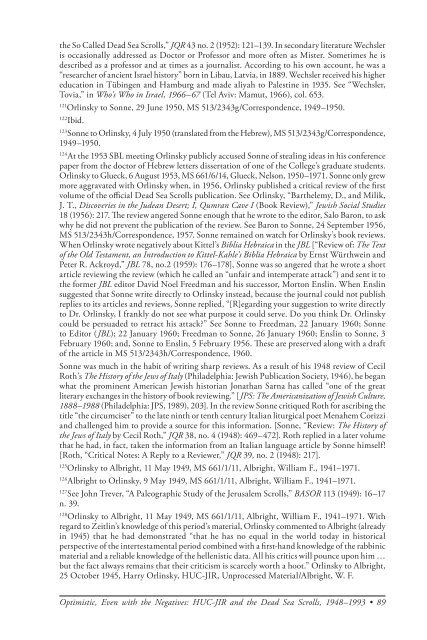The American Jewish Archives Journal, Volume LXI 2009, Number 1
The American Jewish Archives Journal, Volume LXI 2009, Number 1
The American Jewish Archives Journal, Volume LXI 2009, Number 1
Create successful ePaper yourself
Turn your PDF publications into a flip-book with our unique Google optimized e-Paper software.
the So Called Dead Sea Scrolls,” JQR 43 no. 2 (1952): 121–139. In secondary literature Wechsler<br />
is occasionally addressed as Doctor or Professor and more often as Mister. Sometimes he is<br />
described as a professor and at times as a journalist. According to his own account, he was a<br />
“researcher of ancient Israel history” born in Libau, Latvia, in 1889. Wechsler received his higher<br />
education in Tübingen and Hamburg and made aliyah to Palestine in 1935. See “Wechsler,<br />
Tovia,” in Who’s Who in Israel, 1966–67 (Tel Aviv: Mamut, 1966), col. 653.<br />
121 Orlinsky to Sonne, 29 June 1950, MS 513/2343g/Correspondence, 1949–1950.<br />
122 Ibid.<br />
123Sonne to Orlinsky, 4 July 1950 (translated from the Hebrew), MS 513/2343g/Correspondence,<br />
1949–1950.<br />
124At the 1953 SBL meeting Orlinsky publicly accused Sonne of stealing ideas in his conference<br />
paper from the doctor of Hebrew letters dissertation of one of the College’s graduate students.<br />
Orlinsky to Glueck, 6 August 1953, MS 661/6/14, Glueck, Nelson, 1950–1971. Sonne only grew<br />
more aggravated with Orlinsky when, in 1956, Orlinsky published a critical review of the first<br />
volume of the official Dead Sea Scrolls publication. See Orlinsky, “Barthelemy, D., and Milik,<br />
J. T., Discoveries in the Judean Desert; I, Qumran Cave I (Book Review),” <strong>Jewish</strong> Social Studies<br />
18 (1956): 217. <strong>The</strong> review angered Sonne enough that he wrote to the editor, Salo Baron, to ask<br />
why he did not prevent the publication of the review. See Baron to Sonne, 24 September 1956,<br />
MS 513/2343h/Correspondence, 1957. Sonne remained on watch for Orlinsky’s book reviews.<br />
When Orlinsky wrote negatively about Kittel’s Biblia Hebraica in the JBL [“Review of: <strong>The</strong> Text<br />
of the Old Testament, an Introduction to Kittel-Kahle’s Biblia Hebraica by Ernst Würthwein and<br />
Peter R. Ackroyd,” JBL 78, no.2 (1959): 176–178], Sonne was so angered that he wrote a short<br />
article reviewing the review (which he called an “unfair and intemperate attack”) and sent it to<br />
the former JBL editor David Noel Freedman and his successor, Morton Enslin. When Enslin<br />
suggested that Sonne write directly to Orlinsky instead, because the journal could not publish<br />
replies to its articles and reviews, Sonne replied, “[R]egarding your suggestion to write directly<br />
to Dr. Orlinsky, I frankly do not see what purpose it could serve. Do you think Dr. Orlinsky<br />
could be persuaded to retract his attack?” See Sonne to Freedman, 22 January 1960; Sonne<br />
to Editor (JBL); 22 January 1960; Freedman to Sonne, 26 January 1960; Enslin to Sonne, 3<br />
February 1960; and, Sonne to Enslin, 5 February 1956. <strong>The</strong>se are preserved along with a draft<br />
of the article in MS 513/2343h/Correspondence, 1960.<br />
Sonne was much in the habit of writing sharp reviews. As a result of his 1948 review of Cecil<br />
Roth’s <strong>The</strong> History of the Jews of Italy (Philadelphia: <strong>Jewish</strong> Publication Society, 1946), he began<br />
what the prominent <strong>American</strong> <strong>Jewish</strong> historian Jonathan Sarna has called “one of the great<br />
literary exchanges in the history of book reviewing.” [ JPS: <strong>The</strong> <strong>American</strong>ization of <strong>Jewish</strong> Culture,<br />
1888–1988 (Philadelphia: JPS, 1989), 203]. In the review Sonne critiqued Roth for ascribing the<br />
title “the circumciser” to the late ninth or tenth century Italian liturgical poet Menahem Corizzi<br />
and challenged him to provide a source for this information. [Sonne, “Review: <strong>The</strong> History of<br />
the Jews of Italy by Cecil Roth,” JQR 38, no. 4 (1948): 469–472]. Roth replied in a later volume<br />
that he had, in fact, taken the information from an Italian language article by Sonne himself!<br />
[Roth, “Critical Notes: A Reply to a Reviewer,” JQR 39, no. 2 (1948): 217].<br />
125Orlinsky to Albright, 11 May 1949, MS 661/1/11, Albright, William F., 1941–1971.<br />
126Albright to Orlinsky, 9 May 1949, MS 661/1/11, Albright, William F., 1941–1971.<br />
127See John Trever, “A Paleographic Study of the Jerusalem Scrolls,” BASOR 113 (1949): 16–17<br />
n. 39.<br />
128Orlinsky to Albright, 11 May 1949, MS 661/1/11, Albright, William F., 1941–1971. With<br />
regard to Zeitlin’s knowledge of this period’s material, Orlinsky commented to Albright (already<br />
in 1945) that he had demonstrated “that he has no equal in the world today in historical<br />
perspective of the intertestamental period combined with a first-hand knowledge of the rabbinic<br />
material and a reliable knowledge of the hellenistic data. All his critics will pounce upon him …<br />
but the fact always remains that their criticism is scarcely worth a hoot.” Orlinsky to Albright,<br />
25 October 1945, Harry Orlinsky, HUC-JIR, Unprocessed Material/Albright, W. F.<br />
Optimistic, Even with the Negatives: HUC-JIR and the Dead Sea Scrolls, 1948–1993 • 89

















